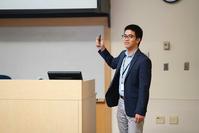2 grad students present at CCAT
NHanCE Lab members Gaojian Huang and Nade Liang presented, and lab member and undergraduate SURF student Alec Gonzales also attended the conference, held at Purdue's Discovery Park on May 31, 2019.
The goal of this conference was to provide opportunities for participants to exchange novel ideas and professional experiences, and discuss case studies and research applications. Presentations featured a variety of research areas and activities including vehicle automation and connectivity, shared mobility, enabling technology, human factors, policy and planning, and infrastructure design and management.
Huang presented his work titled, "Predicting Mind Wandering during Semi-autonomous Driving and Exploring Potential Mitigation Strategies," and won one of two Outstanding Speaker Awards for Best Presentation. Liang also presented his research titled, "The Effect of Secondary Cognitive Task Difficulty on Headway Maintenance and Perceived Workload with Lane Keeping Systems."
ABSTRACT - "Predicting Mind Wandering During Semi-Autonomous Driving and Exploring Potential Mitigation Strategies"
However, little work has been done to understand its impact on autonomous driving, which is important given that current automated vehicle functions can fail as a result of complex construction areas, high traffic volume, and/or missing lane markers. In these cases, drivers may need to be ready to take over control from the vehicle at any time. In addition, physiological measurements, such as pupil size, heart rate, and/or skin conductance level, may be used to predict mental states. Yet, it is unclear which particular techniques can differentiate between mind wandering and attentive states. Monitoring mental states and driving performance are both prerequisites to designing effective warning signals that take drivers out of a mind wandering state and bring them back into the loop. Multisensory interfaces may serve as a feasible approach to alerting systems, however, more research is needed to determine their potential benefits. Given these research gaps, this work aims to take initial steps towards (a) quantifying the effects that mind wandering semi-autonomous driving performance, (b) developing a model to predict when a person is mind wandering based on driving performance and physiological data, and (c) investigating the effectiveness uni-, bi-, and trimodal combinations of visual, auditory, and tactile cues to represent takeover alerts.



